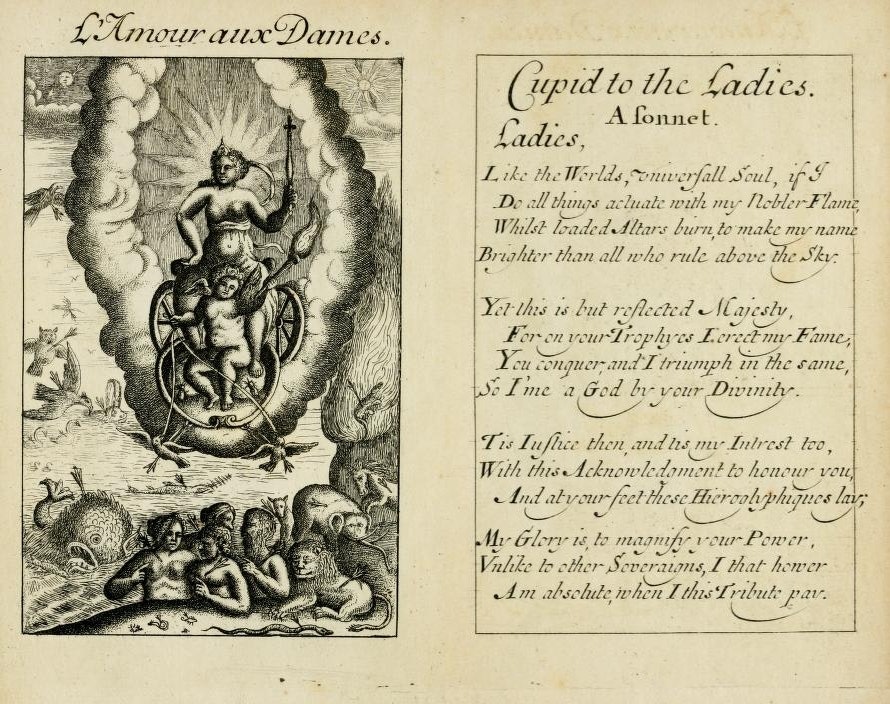
Emblems of Love, in Four Languages: Dedicated to the Ladys (1683)
This excellently sub-titled love emblem book from the English poet Philip Ayres is a reworking of emblems originally found in the earlier Thronus Cupidinis. Each of the forty-four cupid-centred emblems are accompanied on the facing page by a quatrain, written out in four languages: Latin, English, Spanish and French. The Quatrains sport some wonderful titles, which at times seem to come straight out of the back catalogue of Mills and Boon - "The Voluntary Prisoner", "The Timerous Adventuror" - and some which offer just straight up advice - "Be Quick and Sure", "Little by Little", "Tis Constancy that Gains the Pryze". The engravings appearing alongside depict cupid in a whole host of different scenarios, including making a barrel, hobbling on one leg, being burnt at the stake, and (seemingly) admonishing a chameleon. In addition to the emblem and quatrain pages, the book begins with a rather wonderful Sonnet, in French and English, the latter titled "Cupid to the Ladies":
Ladies,
Like the Worlds, universall Soul, if I
Do all things actuate with my Nobler Flame,
Whilst loaded Altars burn to make my name
Brighter than all who rule above the Sky.
Yet this is but reflected Majesty,
For on your Trophyes I erect my Fame,
You conquer and I triumph in the same,
So I'me a God by your Divinity.
Tis Iustice then, and tis my Interest too,
With this Acknowledgment to honour you,
And at your feet these Hieroglyphiques lay;
My Glory is to magnify your power,
Unlike to other Soveraigns, I that hover[?]
Am absolute, when I this Tribute pay.
 Scroll through the whole page to download all images before printing.
Scroll through the whole page to download all images before printing.The volume exists in a few different English versions, one of which replaces the sonnet above with a rather more mournful affair, titled "Cupid to Chloe Weeping" (see it here). Interestingly, as Alison Saunders notes in her The Seventeenth-century French Emblem: A Study in Diversity (2000), this London-published emblem book, which based on originally Dutch material, soon found its way back to the Netherlands. In this Dutch edition (see it here) the English versions of the quatrain were replaced with Dutch versions. Over the next decade the book migrated further east with a version popping up in Augsburg in 1699, this time under the title Triumphis Amoris and with German replacing the English/Dutch (see it here). The emblem book phenomenon was a truly pan-European affair, as Saunders notes, "Tracing the various migrations across Europe of the love emblems created in the Netherlands by Heinsius and Vaenius, in their various polyglot forms - emblems which, themselves, owed considerable debt to influences from other parts of Europe, shows clearly the extent to which the emblem had become a cross-European phenomenon, accessible to all reading publics either in a Latin text or in one or other of the various European vernanculars included in them."
Feb 12, 2015









